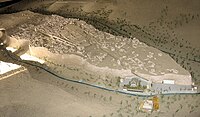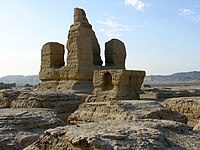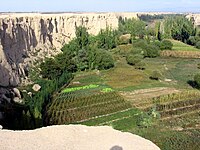Jushi Kingdom
Jushi 車師 | |
|---|---|
| 108 BC–450 AD | |
| Status | Kingdom |
| Capital | Jiaohe (交河) |
| Government | Monarchy |
| History | |
• Established | 108 BC |
• Vassal of the Tang dynasty | 60 BC |
• Destroyed by the Northern Liang | 450 AD |
The Jushi (Chinese: 車師; pinyin: Jūshī, sometimes pronounced Cheshi), or Gushi (Chinese: 姑師; pinyin: Gūshī), were a people probably associated with the Subeshi culture,[1] who established a kingdom during the 1st millennium BC in the Turpan basin (modern Xinjiang, China).[2] The kingdom included the area of Ayding Lake, in the eastern Tian Shan range. During the late 2nd and early 1st century BC, the area was increasingly dominated by the Han dynasty and the northern neighbours of the Jushi, the Xiongnu, and became one of the many minor states of the Western Regions of Han dynasty China. In 450 AD the Northern Liang destroyed the state of Jushi (車師) and occupied its capital city of Jiaohe 交河 (Yarkhoto).[3] Jiaohe, later known as Yarkhoto and Yarghul, was destroyed in a Mongol attack in the 13th century.
The Jushi may have been one of the Tocharian peoples and spoken one of the associated languages.[4]
Historical accounts
[edit]
According to J. P. Mallory and Victor H. Mair, the earliest accounts of the Jushi report them to have "lived in tents, followed the grasses and waters, and had considerable knowledge of agriculture. They owned cattle, horses, camels, sheep and goats. They were proficient with bows and arrows".[5]
Jushi and the kingdom of Krorän were linked in the account of Zhang Qian (d. 113 BC), in part because both were under the control of the Xiongnu.
In or about 60 BC, the Han—ruled at the time by Emperor Xuan—defeated Xiongnu forces at the Battle of Jushi, during the Han–Xiongnu War. Afterwards the main part of the Jushi lands was divided into two states: a southern area controlled by the Han, who referred to it as “Nearer Jushi” (or "Anterior Jushi"), and a northern area known to the Han as “Further Jushi" (or "Posterior Jushi") that was dominated by the Xiongnu. Nearer Jushi was administered by the Han from a capital at Jiaohe (16 kilometres west of the site of modern Turpan). The capital of Further Jushi appears to have been called Yuli or Yulai, and was located about 10 km north of Jimasa, 200 km north of Jiaohe.[6] The Jushi never regained their independence.
Around 442, Juqu Wuhui and Juqu Anzhou of the Northern Liang fled to Gaochang after their defeat against the Northern Wei. They ousted the local Gaochang governor Kan Shuang (闞爽) who escaped to the Rouran Khaganate, and they established the state of Greater Liang (大涼) in Gaochang, the "Northern Liang of Gaochang". They destroyed the state of Jushi (車師) in 450 AD and occupied the Jushi capital of Jiaohe (交河, Yarkhoto).[3]
In 460, the Rouran invaded the area, killed Juqu Anzhou, and established the first Gaochang Kingdom under the Chinese Kan Bozhou (闞伯周, r. 460–ca. 477), who was succeeded in 477 by his son Yicheng (義成).[3]
In 488 the king of the Turkic Gaoju (高車) Afuzhiluo (阿伏至羅), an enemy of the Rouran, took over Gaochang, and established the Zhang dynasty of rulers, starting with Zhang Mengming 張孟明 (r. 491–496) as king of Gaochang.[3]
-
Ancient capital city of Jiaohe (交河, Yarkhoto) on its plateau (model)
-
Ruins of Jiaohe
-
Buddhist stupa of Jiaohe
-
Landscape at the foot of the plateau on which Jiaohe is located
Archaeology
[edit]
A 2,700-year-old grave discovered in 2008 at the Yanghai Tombs, an ancient cemetery (54,000 m2 in area), has been attributed to the Jushi or a precursor culture. The remains belonged probably to a shaman. Near the shaman's head and foot were a large leather basket and wooden bowl filled with 789 grams of dried cannabis, superbly preserved by climatic and burial conditions. An international team demonstrated that this material contained tetrahydrocannabinol, the psychoactive component of cannabis. The cannabis was clearly "cultivated for psychoactive purposes," rather than as fibre for clothing or as food.[8] It may have been employed as a medicinal agent, or an aid to divination. This is the oldest known use of cannabis as a pharmacological agent.[8] The extremely dry conditions and alkaline soil acted as preservatives, allowing a team of scientists to carefully analyze the stash, which still looked green though it had lost its distinctive odour.
A horse saddle made of cow hide was discovered inside a woman's grave at the Yanghai Tombs, dating to between 727 and 396 BC.[9] A second, badly fragmented saddle was found next to a man, in a tomb dated between 700 and 300 BC, making these possibly the earliest saddles in the world, slightly predating the saddles of the Pazyryk culture.[9]
See also
[edit]References
[edit]Citations
[edit]- ^ Beck, Ulrike; Wagner, Mayke; Li, Xiao; Durkin-Meisterernst, Desmond; Tarasov, Pavel E. (20 October 2014). "The invention of trousers and its likely affiliation with horseback riding and mobility: A case study of late 2nd millennium BC finds from Turfan in eastern Central Asia". Quaternary International. 348: 225–226. Bibcode:2014QuInt.348..224B. doi:10.1016/j.quaint.2014.04.056. ISSN 1040-6182.
The Yanghai graveyard is assigned to the Subeixi (Subeshi) culture (e.g. Jiang et al., 2006, 2009), conventionally dated to the first millennium BC (Chen, 2002; Han, 2007; Xinjiang, 2011). The culture is associated with the Cheshi (Chü-shih) state known from Chinese historical sources (Sinor, 1990).
- ^ Jan Romgard, “Ancient Human Settlements in Xinjiang and the Early Silk Road Trade” Sino-Platonic Papers, 185 (November, 2008)[1][permanent dead link]
- ^ a b c d e Rong, Xinjian (24 October 2022). "Gaochang in the Second Half of the 5th Century and Its Relations with the Rouran Qaghanate and the Kingdoms of the Western Regions". The Silk Road and Cultural Exchanges between East and West. Brill. p. 66. doi:10.1163/9789004512597_006. ISBN 978-90-04-51259-7.
- ^ Mallory, J. P. (2015). "The Problem of Tocharian Origins: An Archaeological Perspective" (PDF). Sino-Platonic Papers: 24.
- ^ Mallory, J. P.; Mair, Victor H. (2000). The Tarim Mummies: Ancient China and the Mystery of the Earliest Peoples from the West. London: Thames & Hudson. pp. 143–144. ISBN 9780500051016.
- ^ Fan Ye , Chronicle on the 'Western Regions' from the Hou Hanshu. (transl. John E. Hill), 2011] "Based on a report by General Ban Yong to Emperor An (107–125 CE) near the end of his reign, with a few later additions." (20 December 2015)
- ^ See: Turpan Museum notice
- ^ a b Russo, Ethan B.; et al. (2008). "Phytochemical and genetic analyses of ancient cannabis from Central Asia". Journal of Experimental Botany. 59 (15): 4171–4182. doi:10.1093/jxb/ern260. PMC 2639026. PMID 19036842.
- ^ a b Wertmann, Patrick (September 2023). "The earliest directly dated saddle for horse-riding from a mid-1st millennium BCE female burial in Northwest China". Archaeological Research in Asia. 35: 100451. doi:10.1016/j.ara.2023.100451.
Sources
[edit]- Hill, John E. (2009) Through the Jade Gate to Rome: A Study of the Silk Routes during the Later Han Dynasty, 1st to 2nd Centuries CE. BookSurge, Charleston, South Carolina. ISBN 978-1-4392-2134-1.
- Hulsewé, A. F. P. (1979). China in Central Asia: The Early Stage 125 BC – AD 23: an annotated translation of chapters 61 and 96 of the History of the Former Han Dynasty. E. J. Brill, Leiden. ISBN 90-04-05884-2.







